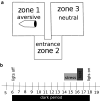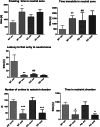Lack of CRH Affects the Behavior but Does Not Affect the Formation of Short-Term Memory
- PMID: 28786031
- PMCID: PMC11481924
- DOI: 10.1007/s10571-017-0532-y
Lack of CRH Affects the Behavior but Does Not Affect the Formation of Short-Term Memory
Abstract
Corticotropin-releasing hormone (CRH) is involved in modification of synaptic transmission and affects spatial discrimination learning, i.e., affects the formation of memory in long-term aspect. Therefore, we have focused on CRH effect on short-term memory. We have used stress task avoidance (maze containing three zones: entrance, aversive, and neutral) and compared the behavior and short-term memory in wild-type mice and mice lacking CRH (CRH KO) experiencing one 120-min session of restraint stress. As control, non-stressed animals were used. As expected, the animals that experienced the stress situation tend to spend less time in the zone in which the restraint chamber was present. The animals spent more time in the neutral zone. There were significant differences in number of freezing bouts in the aversive and entrance zones in CRH KO animals. CRH KO control animals entered the neutral zone much more faster than WT control and spent more time immobile in the neutral zone than WT control. These data give evidence that lacking of CRH itself improves the ability of mice to escape away from potentially dangerous area (i.e., those in which the scent of stressed animal is present).
Keywords: CRH; Post-stress period; Restraint stress; Stress task avoidance; Working memory.
Conflict of interest statement
The authors declare no conflict of interest.
Figures




Similar articles
-
Impaired basal and restraint-induced epinephrine secretion in corticotropin-releasing hormone-deficient mice.Endocrinology. 2000 Mar;141(3):1142-50. doi: 10.1210/endo.141.3.7370. Endocrinology. 2000. PMID: 10698191
-
Stress-induced behaviors require the corticotropin-releasing hormone (CRH) receptor, but not CRH.Proc Natl Acad Sci U S A. 1999 Jul 6;96(14):8283-8. doi: 10.1073/pnas.96.14.8283. Proc Natl Acad Sci U S A. 1999. PMID: 10393986 Free PMC article.
-
Expression of type 1 corticotropin-releasing hormone (CRH) receptor mRNA in the hypothalamic paraventricular nucleus following restraint stress in CRH-deficient mice.Brain Res. 2005 Jun 28;1048(1-2):131-7. doi: 10.1016/j.brainres.2005.04.065. Brain Res. 2005. PMID: 15919058
-
Animal models of CRH deficiency.Front Neuroendocrinol. 1999 Apr;20(2):122-45. doi: 10.1006/frne.1999.0179. Front Neuroendocrinol. 1999. PMID: 10328987 Review.
-
5-HT1A receptor knockout mice and mice overexpressing corticotropin-releasing hormone in models of anxiety.Eur J Pharmacol. 2003 Feb 28;463(1-3):185-97. doi: 10.1016/s0014-2999(03)01281-0. Eur J Pharmacol. 2003. PMID: 12600710 Review.
Cited by
-
The effects of stress on avoidance in rodents: An unresolved matter.Front Behav Neurosci. 2022 Sep 28;16:983026. doi: 10.3389/fnbeh.2022.983026. eCollection 2022. Front Behav Neurosci. 2022. PMID: 36275848 Free PMC article. Review.
References
-
- Bailer UF, Kaye WH (2003) A review of neuropeptide and neuroendocrine dysregulation in anorexia and bulimia nervosa. Curr Drug Targets CNS Neurol Disord 2(1):53–59 - PubMed
-
- Chen Y, Molet J, Lauterborn JC, Trieu BH, Bolton JL, Patterson KP, Gall CM, Lynch G, Baram TZ (2016) Converging, synergistic actions of multiple stress hormones mediate enduring memory impairments after acute simultaneous stresses. J Neurosci 36(44):11295–11307. doi:10.1523/jneurosci.2542-16.2016 - PMC - PubMed
MeSH terms
Substances
Grants and funding
LinkOut - more resources
Full Text Sources
Other Literature Sources
Medical
Molecular Biology Databases
Research Materials

